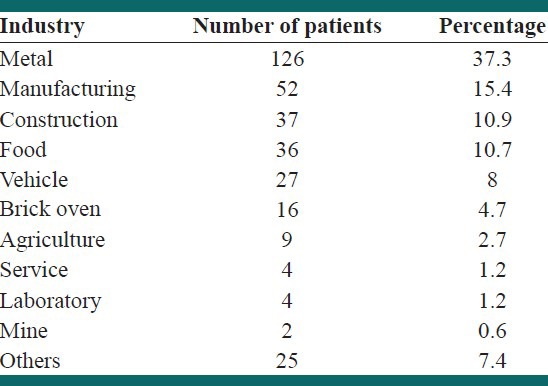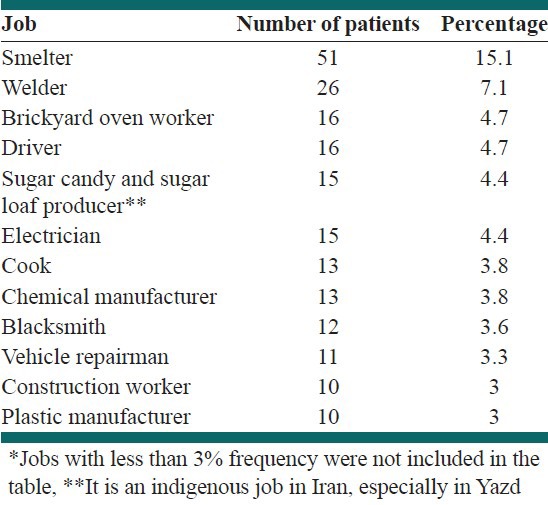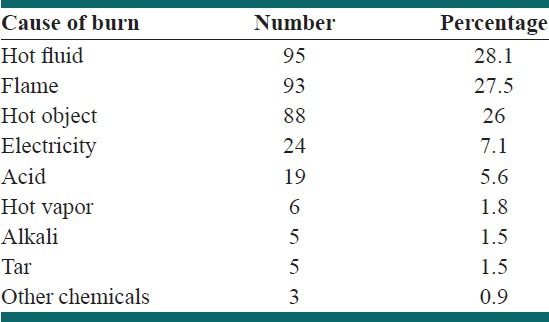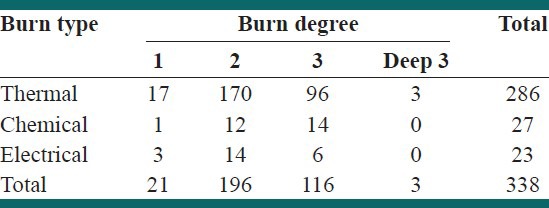Abstract
Objective:
Occupational burns are among the important causes of work-related fatalities and absenteeism. Epidemiologic assessment of these injuries is important to define high-risk jobs. We designed this study to evaluate the epidemiology of occupational burns in Yazd, an industrial province in Iran.
Methods:
This is a prospective study on work-related burns in a 1-year period (2008-2009). A questionnaire was completed for them about the characteristics of the burn injury.
Results:
Three Hundred and Thirty Eight patients with occupational burns were identified. Their mean age was 29.64 years. Most burn victims were male workers in the metal industry. The most common job was smelting. Most burns were happened in the morning. Thermal burns were observed more than chemical and electrical burns. Mean total body surface area burned was 6.5%. The most common cause of burn was hot fluid, followed by hot object and flame. There was no any significant relationship between burn type, and burn degree or burned body surface.
Conclusions:
The highest incidence of occupational burns was in 21-30 year-old workers. There was a male preponderance in work-related burns. Metal industry had the most injured workers and among them, smelters were more frequently injured.
Keywords: Epidemiology, metal industry, occupational burn, thermal burn
INTRODUCTION
Injuries are one of the most critical public health problems in various populations. One of the important kinds of injuries are burns. They cause more than 1% of the global burden of disease.[1] Burn injuries still produce a significant morbidity and mortality.[2,3] Burns sustained while performing employment duties are called occupational or work-related burns. These injuries are relatively common, and the causative agent of the burn and incidence varies by occupation.[4,5] Burns in the workplace are an important social and economic threat to the workers, their families, and to the community.[4]
Evaluation and analysis of occupational burns, their causes, types, and severity is important to find high-risk jobs or tasks and establish safety interventions in order to decrease the frequency of burns. Occupational burns are among the important causes of work-related fatalities and disability leave among workers. Burn injuries may result in disability and considerable periods of absenteeism, hence substantial costs to both employee and employer.[5,6,7]
There are many studies on occupational burn and its epidemiology in different countries.[8,9,10,11,12,13,14,15,16] There are also some studies, which have assessed only one type of burn or a unique industry.[17,18] The incidence of occupational burns is different worldwide and is dependent on many factors naming some of them: Socioeconomic status, safety and health background, industrialization and so on. Occupational burns are reported to account for 10-45% of all burn injuries in different studies.[10,12,16,19]
Munnoch reported a 20% incidence for occupational injuries among all burns in South Whales in 2000.[12] Smith et al. reported that 183,000 burns occur annually in the US, representing a rate of 3.3% of all work-related injuries and constitute 42.1% of total burn injuries,[19] but this incidence in the study of Rossignol was 29%[10] and in the study of Mandelcorn was 28% among hospitalized patients.[7] In the study of Islam et al., the annual incidence rate of occupational burns was 26.4 per 10,000 workers.[20] Another study from Singapore showed an incidence of 45% of all hospital admissions in burn hospitals for work-related burns.[16] Mirmohammadi et al. found an incidence of 20.3% for occupational burns in Iran.[3]
Occupational burns such as burns in the general population are mostly thermal and chemical, and electrical burns are in the second order,[8,13,21] although Mandelcorn showed a higher incidence of electrical burns, but he had assessed only hospitalized patients.[7]
The incidence of occupational burns is different in various industries and workplaces. Welders, cooks, laborers, and mechanics,[20] workers involved in food preparation or food handling, smelting, sintering, or refining of ore, paper, pulp, or wood fiber manufacturing,[8] vehicle and equipment cleaners, food service personnel, and millwrights,[11] and kitchen workers[21] were among the most frequent workers suffered from occupational burn.
The most common cause of occupational burns is different and includes: Hot water/steam[8] scalds,[9] caustics and hot objects and substances,[11] flame and scalds,[12] electrical, flame,[14] scalds and flame,[15] scalds.[16]
In our country, there is only one study about the epidemiology of electrical burns in Shira[17] and we couldn’t find any other researches on occupational burns.
Considering Yazd as an industrial province in Iran with various industries, we designed this study to evaluate the epidemiology of occupational burns in this city.
MATERIALS AND METHODS
A prospective study has been made of the epidemiology of work-related burns in Yazd in a 1-year period from September 1, 2008 till September 1, 2009. There is only one burn hospital in Yazd. During this period, 1978 burn victims referred to this hospital, and those patients whose burn was considered to be work-related (burn, which was happened while performing their work-place tasks) were selected, and all of them (338 persons) entered into the study, and their job characteristics were assessed in detail. We didn’t have any exclusion criteria.
Yazd is an industrial province in the center of Iran. The most frequent industries in this province include: Tile and ceramic manufacturing, textile, metal industries, and mines.
We gathered our data in this hospital using a questionnaire including demographic data (age, gender, educational status, and place of residence) and data about the properties of the burn injury (degree, area, type, and causing agent). Data was gathered by 3 physicians who were the first persons visiting the injured patient.
Total body surface area burned (TBSA) was estimated by Lund and Browder chart.[22]
We considered the highest degree of the burn as the reported burn degree.
Data was analyzed by SPSS (ver. 17) using T test, Chi-square test, and ANOVA. A P value of < 0.05 was considered to be statistically significant.
An informed consent was obtained from each subject. This project was approved by the ethics committee of research vice chancellor of Shahid Sadoughi University of medical sciences.
RESULTS
From all injured patients referred to the burn hospital, 338 patients (17.1%) had occupational burns. Their mean age was 29.64 ± 9.28 years (range: 12-65). Most subjects were males (98.5%), and 1.5% of subjects were females.
Educational status had an inverse relationship with the incidence of the burns, i.e. most patients (218 persons, 64.5%) were under high school graduate, and 78 (23.1%), 28 (8.3%), 1 (0.3%), and 1 (0.3%) had post-high-school, bachelor, master, and PhD certificates, respectively. Eleven patients (3.3%) didn’t answer to this question.
The most frequent industry involved was metal industry. [Table 1] shows the frequency of burns in various industries.
Table 1.
Frequency of occupational burns in various industries

Table 2 shows different job titles with the number and percentage of burn injuries.
Table 2.
Frequency of burns in different jobs*

More than half of the subjects (58.3%) worked in a shift work schedule, and 115 (34%) didn’t have a shift work schedule. Twenty-seven subjects (7.7%) didn’t answer to this question. Most accidents happened in the morning (53%), and 25% and 22% happened in the afternoon and at night, respectively.
Table 3 shows the frequency of burn type.
Table 3.
Frequency of burn type

Mean TBSA was 6.5 ± 9.4% (range: 0.5-90%). The most frequent cause of burn was hot fluid (28.1%). [Table 4] shows the causes of occupational burns.
Table 4.
Frequency of various causes of burns

Hands were most frequently affected (51.5%), and the frequency of burns in other body areas was: 36.9%, 28.9%, 12.1%, 6.2%, 1.8%, and 1.8% for lower extremities, head and face (excluding eyes), upper extremities (excluding hands), trunk, genitalia, and eyes, respectively.
Second-degree burns were the most frequent ones (58%), and the frequency of first degree, third degree, and deep third degree burns was 6.3%, 34.5%, and 0.9%, respectively.
Most injured workers (88.2%) were treated without hospital admission, and only 11.8% of them needed an inpatient treatment.
Workers between 21-30 years old were more affected by burn injuries (48.5% of all cases), although this range of age is more populous among workers in Yazd. [Table 5] shows the association between burn type and burn degree. There wasn’t any statistically significant association between these two variables (P = 0.229) [Table 5].
Table 5.
The association between burn type and burn degree

There wasn’t any correlation between burn type and treatment modality (inpatient or outpatient) (P = 0.55), and the relationship between burn type and TBSA was not statistically significant (P = 0.12).
DISCUSSION
Occupational burns cause significant morbidity and hence absenteeism in different industries worldwide. The epidemiology of occupational burns differs according to the industries, socio-economic status, and many other factors. Therefore, we aimed to study the epidemiology of occupational burns in an industrial province in Yazd, Iran.
In our study, there was a male predominance of occupational burn injuries, which was consistent with Lyngdorf, Munnoch, and Khoo,[9,12,16] although the number of female workers in Yazd is much less than male workers.
The industry with most number of burns in our study was metal industry followed by manufacturing, construction, and food industries. In other studies with some differences, mostly workers in metal and food industries are affected.[8,11,20] This frequency is dependent on the local industries, and the number of workers in each industry and the difference observed in different areas is acceptable. In Yazd, metal industry is a large industry with many workers. But, there are much less workers in the food industry.
The most frequent cause of burn in our study was hot fluid, although the cause of burns in different studies was different, for example, hot water/steam in the study of McCullough et al.,[8] scalds in the study of Lyngdorf et al.,[9] caustics and hot objects and substances in the study of Hunt et al.,[11] flame and scalds in the study of Munnoch et al.[12] This difference can be explained by different industries in different areas as well.
Second-degree burns were more common than others, although it is obvious that many patients suffering from first degree burns do not refer to the hospital. Workers between 21-30 years old were more affected by burn injuries (48.5% of all cases). This age range is more populous in Yazd factories.
The most frequent burn type in our study as well as in many other studies was thermal burn.[8,13,21] The burn type didn’t have any statistically significant relationship with burn degree or area of the body affected.
Our study had some limitations: Some of the burn victims in Yazd referred to a traditional private center for treatment and therefore we couldn’t assess them. Some patients suffering from only eye burn referred to another hospital and hence they were not included in our study; therefore, the statistics about eye burns may be underestimated. Many patients with first-degree burns do not refer to the hospital, so the frequency of this kind of burn is not precise in this study.
CONCLUSIONS
The highest incidence of occupational burns was in 21-30 year-old workers. There was a male preponderance in work-related burns. Metal industry had the most injured workers and among them, smelters were more frequently injured. The most common type of burn was thermal burn, and the most common cause was hot liquid. Hands were the body part most frequently injured.
Footnotes
Source of Support: Nil
Conflict of Interest: None declared
REFERENCES
- 1.Leistikow BN, Martin DC, Milano CE. Fire injuries, disasters and costs from cigarettes lights, a global overview. Prev Med. 2000;31:91–9. doi: 10.1006/pmed.2000.0680. [DOI] [PubMed] [Google Scholar]
- 2.Rastegar Lari A, Alaghehbandan R, Nikui R. Epidemiological study of 3341 burns patients during 3 years in Tehran, Iran. Burns. 2000;26:49–53. doi: 10.1016/s0305-4179(99)00102-3. [DOI] [PubMed] [Google Scholar]
- 3.Mirmohammadi SJ, Mehrparvar AH, Jalilmanesh M, Kazemeini K, Delbari N, Mostaghaci M. An Epidemiologic Survey on Burns in Yazd from 2008 till 2009. Acta Medica Iranica. 2012;50:70–5. [PubMed] [Google Scholar]
- 4.Mian MAH, Mullins RF, Alam B, Brandigi C, Friedman BC, Shaver JR, et al. Workplace-related burns. Ann Burns Fire Disasters. 2011;24:89–93. [PMC free article] [PubMed] [Google Scholar]
- 5.Pruitt VM. Work-related burns. In: Derebery J, Kasdan ML, Gonzalez R, editors. Clinics in occupational and environmental medicine. Philadelphia: WB Saunders; 2006. pp. 423–6. [DOI] [PubMed] [Google Scholar]
- 6.Smith GS, Wellman HM, Sorock GS, Warner M, Courtney TK, Pransky GS, et al. Injuries at work in the US adult population: Contributions to the total injury burden. Am J Public Health. 2005;95:1213–9. doi: 10.2105/AJPH.2004.049338. [DOI] [PMC free article] [PubMed] [Google Scholar]
- 7.Mandelcorn E, Gomez M, Cartotto RC. Work-related burn injuries in Ontario, Canada: Has anything changed in the last 10 years? Burns. 2003;29:469–72. doi: 10.1016/s0305-4179(03)00063-9. [DOI] [PubMed] [Google Scholar]
- 8.McCullough JE, Henderson AK, Kaufman JD. Occupational Burns in Washington State, 1989-1993. J Occup Environ Med. 1998;40:1083–9. doi: 10.1097/00043764-199812000-00008. [DOI] [PubMed] [Google Scholar]
- 9.Lyngdorf P. Occupational burn injuries. Burns Incl Therm Inj. 1987;13:294–7. doi: 10.1016/0305-4179(87)90049-0. [DOI] [PubMed] [Google Scholar]
- 10.Rossignol AM, Locke JA, Boyle CM, Burke JF. Epidemiology of work-related burn injuries in Massachusetts requiring hospitalization. J Trauma. 1986;26:1097–101. doi: 10.1097/00005373-198612000-00007. [DOI] [PubMed] [Google Scholar]
- 11.Hunt JP, Calvert CT, Peck MD, Meyer AA. Occupation-related burn injuries. J Burn Care Rehabil. 2000;21:327–32. doi: 10.1067/mbc.2000.108092. [DOI] [PubMed] [Google Scholar]
- 12.Munnoch DA, Darcy CM, Whallett EJ, Dickson WA. Work-related burns in South Wales 1995-96. Burns. 2000;26:565–70. doi: 10.1016/s0305-4179(00)00009-7. [DOI] [PubMed] [Google Scholar]
- 13.Carroll SM, Gough M, Eadie PA, McHugh M, Edwards G, Lawlor D. A 3-year epidemiological review of burn unit admissions in Dublin, Ireland: 1988-91. Burns. 1995;21:379–82. doi: 10.1016/0305-4179(94)00019-0. [DOI] [PubMed] [Google Scholar]
- 14.Ng D, Anastakis D, Douglas LG, Peters WJ. Work-related burns: A 6-year retrospective study. Burns. 1991;17:151–4. doi: 10.1016/0305-4179(91)90140-c. [DOI] [PubMed] [Google Scholar]
- 15.Inancsi W, Guidotti TL. Occupation-related burns: Five year experience of an urban burn center. J Occup Med. 1987;29:730–3. [PubMed] [Google Scholar]
- 16.Khoo AK, Wee JT, Ngim RC, Wong MK. Occupational burns in the burns center at the Singapore General Hospital. Ann Acad Med Singapore. 1994;23:680–3. [PubMed] [Google Scholar]
- 17.Mohammadi AA, Amini M, Mehrabani D, Kiani Z, Seddigh A. A survey on 30 months electrical burns in Shiraz University of Medical Sciences Burn Hospital. Burns. 2008;34:111–3. doi: 10.1016/j.burns.2006.12.007. [DOI] [PubMed] [Google Scholar]
- 18.Fordyce TA, Kelsh M, Lu ET, Sahl JD, Yager JW. Thermal burn and electrical injuries among electric utility workers, 1995-2004. Burns. 2007;33:209–20. doi: 10.1016/j.burns.2006.06.017. [DOI] [PubMed] [Google Scholar]
- 19.Smith GS, Wellman HM, Sorock GS, Warner M, Courtney TK, Pransky GS, et al. Injuries at work in the US adult population: Contributions to the total injury burden. Am J Public Health. 2005;95:1213–9. doi: 10.2105/AJPH.2004.049338. [DOI] [PMC free article] [PubMed] [Google Scholar]
- 20.Islam SS, Nambiar AM, Doyle EJ, Velilla AM, Biswas RS, Ducatman AM. Epidemiology of work-related burn injuries: Experience of a state-managed workers’ compensation system. J Trauma. 2000;49:1045–51. doi: 10.1097/00005373-200012000-00012. [DOI] [PubMed] [Google Scholar]
- 21.Horwitz IB, McCall BP. A Quantification and Risk Analysis of Occupational Burns: Oregon Workers’ Compensation Claims 1990-1997, Industrial Relations Center, University of Minnesota. [Last accessed on 2012 Mar 15]. Available from: http://www.legacy-irc.csom.umn.edu/RePEC/hrr/papers/0403.pdf .
- 22.Lund CC, Browder NC. Estimation of areas of burn. Surg Gynecol Obstet. 1944;79:352–8. [Google Scholar]


